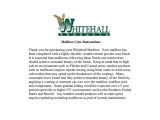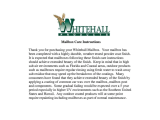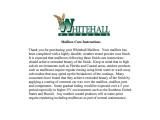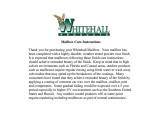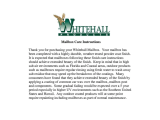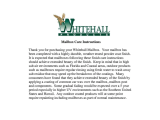Page is loading ...

Xtrinsic
Intelligent Sensing Framework v1.1
Software Reference Manual
on the FXLC95000 Intelligent Motion-Sensing Platform
Document Number: ISF1P195K_SW_REFERENCE_RM
Rev 1.0, 2/2014

Xtrinsic Intelligent Sensing Framework v1.1 Software Reference Manual, Rev. 1.0, 2/2014
2 Freescale Semiconductor, Inc.

Contents
Section number Title Page
Chapter 1
About This Document
1.1 Purpose.............................................................................................................................................................................7
1.2 Audience...........................................................................................................................................................................7
1.3 Terminology and Conventions.........................................................................................................................................7
1.3.1 Technical Terms..................................................................................................................................................7
1.3.2 Abbreviations.......................................................................................................................................................9
1.3.3 Notational Conventions.......................................................................................................................................10
1.4 References........................................................................................................................................................................11
Chapter 2
Introduction
2.1 FXLC95000 System Overview........................................................................................................................................13
2.1.1 Development System Requirements....................................................................................................................15
2.2 FXLC95000CL Hardware Device....................................................................................................................................15
Chapter 3
Intelligent Sensing Framework
3.1 ISF Architecture...............................................................................................................................................................17
3.2 Application Support..........................................................................................................................................................19
3.2.1 Freescale MQX™ RTOS Components...............................................................................................................19
3.2.1.1 Component Configuration...................................................................................................................20
3.2.1.2 ISF Tasks and Initialization.................................................................................................................20
3.2.2 Freescale MQX™ RTOS Port for FXLC95000..................................................................................................22
3.2.2.1 Bootup Reset........................................................................................................................................22
3.2.2.2 RTOS Timer........................................................................................................................................22
3.2.2.3 Linker File Memory Map....................................................................................................................23
3.2.2.4 Queued SPI Module Configuration.....................................................................................................24
3.2.2.5 Task Memory Deallocation.................................................................................................................24
3.2.2.6 Servicing Non-Maskable Interrupts.....................................................................................................25
Xtrinsic Intelligent Sensing Framework v1.1 Software Reference Manual, Rev. 1.0, 2/2014
Freescale Semiconductor, Inc. 3

Section number Title Page
3.2.3 Freescale MQX™ RTOS Task Preemption Control Considerations..................................................................25
3.3 Communications...............................................................................................................................................................26
3.3.1 ISF Command Interpreter....................................................................................................................................26
3.3.2 Mailbox Interface.................................................................................................................................................27
3.3.3 The Command/Response Paradigm.....................................................................................................................28
3.3.3.1 Command Response Mailbox Layout.................................................................................................29
3.3.3.2 Command Processing..........................................................................................................................30
3.3.4 The Quick-Read Paradigm..................................................................................................................................32
3.3.4.1 Quick-Read Mailbox Layout...............................................................................................................34
3.3.4.2 Configuring the Quick-Read Mailboxes..............................................................................................35
3.3.4.3 Mailbox Application Control Config Register....................................................................................40
3.3.5 Device Messaging................................................................................................................................................41
3.3.5.1 Device Messaging concepts.................................................................................................................42
3.3.5.2 Usage Example....................................................................................................................................44
3.3.6 Host Proxy...........................................................................................................................................................45
3.3.6.1 Host Proxy Concepts and Theory of Operation...................................................................................45
3.3.6.2 Implementing a Proxy Application using the Host Proxy...................................................................47
3.3.7 I2C Master Interfaces..........................................................................................................................................53
3.3.7.1 Theory of Operation............................................................................................................................53
3.3.7.2 Bus Locking.........................................................................................................................................53
3.3.7.3 Usage Example....................................................................................................................................54
3.3.8 Communications Channel Configuration............................................................................................................55
3.3.9 Bus Management.................................................................................................................................................55
3.3.10 Built-in Commands..............................................................................................................................................57
3.3.10.1 Device Info command..........................................................................................................................57
3.4 Sensor Management.........................................................................................................................................................59
3.4.1 Sensor Manager Signal Tap Mechanism.............................................................................................................61
3.4.2 Sensor Manager Subscription Tokens.................................................................................................................61
Xtrinsic Intelligent Sensing Framework v1.1 Software Reference Manual, Rev. 1.0, 2/2014
4 Freescale Semiconductor, Inc.

Section number Title Page
3.4.3 Using the Sensor Management API ....................................................................................................................61
3.4.3.1 Sensor Manager Subscription Quality of Service................................................................................64
3.4.3.2 Sensor Subscription Compatibility .....................................................................................................65
3.4.4 Digital Sensor Abstraction (DSA).......................................................................................................................66
3.4.4.1 Digital Sensor Abstraction Theory of Operation.................................................................................67
3.4.4.2 Implementing a New Digital Sensor Abstraction Adapter..................................................................68
3.4.5 System Configuration..........................................................................................................................................69
3.5 Power Management..........................................................................................................................................................70
3.5.1 Power Management Concepts and Theory of Operation.....................................................................................70
3.5.2 Power Management Design.................................................................................................................................71
3.5.3 Power Level implementations for the FXLC95000.............................................................................................72
3.5.4 Using the Power Management Interfaces............................................................................................................73
3.5.5 Timer Service.......................................................................................................................................................73
3.6 Application Integration.....................................................................................................................................................74
3.6.1 Interrupt Output Integration.................................................................................................................................77
Xtrinsic Intelligent Sensing Framework v1.1 Software Reference Manual, Rev. 1.0, 2/2014
Freescale Semiconductor, Inc. 5

Xtrinsic Intelligent Sensing Framework v1.1 Software Reference Manual, Rev. 1.0, 2/2014
6 Freescale Semiconductor, Inc.

Chapter 1
About This Document
1.1 Purpose
This reference manual describes the features, architecture, and programming model of the
FXLC95000 system. The system includes the Xtrinsic FXLC95000CL device, the
Freescale MQX
TM
firmware, the Xtrinsic Intelligent Sensing Framework (ISF) firmware,
and embedded applications which leverage the ISF. This document focuses on the core
ISF functionality and its use to build user embedded applications. Comprehensive
documents that focus on installation instructions, release notes, application development
and API for ISF are listed in References and are available on the Xtrinsic ISF website.
1.2 Audience
This document is primarily for system architects and software application developers
currently using or considering use of the FXLC95000 platform as the basis for an
intelligent sensor system in an end-user product.
1.3 Terminology and Conventions
This section defines the terminology, abbreviations, and other conventions used
throughout this document.
1.3.1 Technical Terms
application callback ID The identifier used by the Command Interpreter to determine which registered callback function
is invoked by the Command Interpreter on behalf of the embedded application. Depending on
the context, the terms application callback ID or application ID or callback ID may be used.
Table continues on the next page...
Xtrinsic Intelligent Sensing Framework v1.1 Software Reference Manual, Rev. 1.0, 2/2014
Freescale Semiconductor, Inc. 7

application ID See application callback ID.
BusHandle A handle identifying the bus to use for I
2
C transactions.
callback See callback function.
callback ID See application callback ID.
callback function A function registered by a software component, invoked on behalf of the registering
component. The function usually contains instructions to communicate with or call back to the
registering component. Also referred to as callback.
channel A representation of a separate communications pathway to one or more external slave devices.
ChannelDescriptor A descriptor identifying the channel for communications using Device Messaging.
DeviceHandle A handle identifying the device used for Device Messaging transactions.
Digital Sensor Abstraction Abstraction layer in the Sensor Manager to enable communications with multiple types of
sensors.
embedded application A program that executes on the intelligent sensing platform as an independent unit of
functionality. It consists of a set of one or more tasks providing outputs consumed outside the
intelligent sensing platform. Independence means that an application may be added or
removed from a firmware build without interfering with the functionality of other applications.
Applications typically are run on behalf of a user as opposed to a simple support task which is
run as part of the Intelligent Sensing Framework.
end-user product A third-party product that hosts a sensing sub-system.
event group A 32-bit group of event bits used to let tasks synchronize and communicate. There are two
event group types: fast event groups and named event groups.
event number The category number, which could be either configuration or data ready.
firmware The combination of code and data stored in a device's flash memory.
framework The infrastructure code providing the execution environment for embedded applications.
function A portion of code taking a pre-defined set of input parameters that performs a series of
instructions and returns a pre-defined set of output values. A function may be invoked from one
or more points in an executable program.
FXLC95000 FXLC95000 firmware—The combination of code and data stored in the FXLC95000CL device's
flash memory.
FXLC95000 intelligent sensor system—The combination of the FXLC95000 platform and
external sensor hardware that interact together via hardware and software protocols. Also
referred to as FXLC95000 system.
FXLC95000 platform—The combination of the FXLC95000CL device and FXLC95000
firmware. Also referred to as FXLC95000 and platform.
FXLC95000 system—The FXLC95000 platform and external sensor hardware that interact
together via hardware and software protocols. Also referred to as FXLC95000 intelligent sensor
system.
FXLC95000CL The physical packaged part. Also referred to as FXLC95000CL hardware device.
host application A program that executes on the host processor.
host proxy An Intelligent Sensing Framework (ISF) component that allows a host processor to remotely
configure and subscribe to all the managed sensors.
intelligent sensing platform The combination of the device and firmware. Also referred to as platform.
Intelligent Sensing
Framework (ISF)
The Freescale-provided software middleware layer enabling the development of custom
embedded sensor applications with increased portability and ease-of-use, and decreased time-
to-market.
intelligent sensor system The platform and external sensor hardware that interact together via hardware and software
protocols. Also referred to as system.
period The time between successive repetitions of a given phenomena. Period is equal to the inverse
of frequency).
Table continues on the next page...
Terminology and Conventions
Xtrinsic Intelligent Sensing Framework v1.1 Software Reference Manual, Rev. 1.0, 2/2014
8 Freescale Semiconductor, Inc.

platform The combination of the device and firmware. Also referred to as intelligent sensing platform.
proxy number A unique number assigned at the time the application is registered with the host proxy.
Sensor Adapter A Sensor Adapter implements the Sensor Manager's Digital Sensor Abstraction interface for a
particular physical sensor and handles the device-specific communications and interactions
with the physical sensor allowing the Sensor Manager to manage sensors at a higher level of
abstraction. ISF requires a Sensor Adapter for each sensor being managed in the system.
sensor ID The enumerated value that indexes into the global sensor configuration array.
service family A logical grouping of software components providing related functionality.
signal tap An access mechanism to sensor data. Also referred to as tap.
SlaveHandle A handle identifying the slave device used for I
2
C transactions.
system The platform and external sensor hardware that interact together via hardware and software
protocols. Also referred to as intelligent sensor system.
tap An access mechanism to sensor data. Also referred to as signal tap.
task An operating entity within the Intelligent Sensing Framework (ISF) scheduled to execute by the
Freescale MQX
TM
RTOS. A task may entail the execution of one or more functions.
transport Communications mechanism.
Examples: I
2
C, Bluetooth©, Ethernet, and USB
token Result of a successful callback function registration with the bus manager used in subsequent
bus management calls to refer to a registered callback function.
vector base register A register in the ColdFire memory map that controls the location of the exception vector table.
1.3.2 Abbreviations
AFE Analog Front End
API Application Programming Interface
BM Bus Manager
BSP Board Support Package
CI Command Interpreter
CMD Command
COCO Conversion Complete (hardware), Command Complete (software)
CRC Cyclic Redundancy Check
CSR Control and Status Register
DFC Data Format Code
DM Device Messaging
DSA Digital Sensor Abstraction
FOPT Flash OPTions register
IIR Infinite Impulse Response
ISF Intelligent Sensing Framework
ISP Intelligent Sensing Platform
ISR Interrupt Service Routine
MB Mailbox
NMI Non-Maskable Interrupt
Table continues on the next page...
Chapter 1 About This Document
Xtrinsic Intelligent Sensing Framework v1.1 Software Reference Manual, Rev. 1.0, 2/2014
Freescale Semiconductor, Inc. 9

PDB Programmable Delay Block
PM Power Manager
POR Power-On-Reset
PSP Processor Support Package
QR Quick-Read
QSPI Queued SPI
RCSR Reset Control and Status Register
SM Sensor Manager
SOF Start Of Frame
SPI Serial Peripheral Interface
VBR Vector Base Register
1.3.3 Notational Conventions
cleared/set When a bit has the value 0, it is said to be cleared; when it has a value of 1, it is said to be set.
MNEMONICS Mnemonics which may represent command names, defined macros, constants, enumeration
values are shown as, for example, CI_DEV_INFO.
programming domain
entity
Entities such as functions, data structures are shown as, for example device_info_t.
0x Prefix to denote a hexadecimal number
h Suffix to denote a hexadecimal number
nibble A 4-bit data unit
byte An 8-bit data unit
word A 16-bit data unit
longword A 32-bit data unit
CAUTION, Note, and Tip statements may be used in this manual to emphasize critical,
important, and useful information. The statements are defined below.
CAUTION
A CAUTION statement indicates a situation that could have
unexpected or undesirable side effects or could be dangerous to
the deployed application or system.
Note
A Note statement is used to point out important information.
Tip
A Tip statement is used to point out useful information.
Terminology and Conventions
Xtrinsic Intelligent Sensing Framework v1.1 Software Reference Manual, Rev. 1.0, 2/2014
10 Freescale Semiconductor, Inc.

1.4 References
1. FXLC95000CL Intelligent, Motion-Sensing Platform Data Sheet: FXLC95000CL,
Freescale Semiconductor, Rev. 1.2, 08/2013 http://www.freescale.com/files/sensors/
doc/data_sheet/FXLC95000CL.pdf
2. FXLC95000CL Intelligent, Motion-Sensing Platform Hardware Reference Manual:
FXLC95000CLHWRM, Rev. 0.6, 05/2013 http://www.freescale.com/files/sensors/
doc/ref_manual/FXLC95000CLHWRM.pdf
3. Release Notes for Intelligent Sensing Framework 1.1 on the FXLC95000 Intelligent
Motion-Sensing Platform: ISF1P1_95K_CORE_LIB_RELEASE_RN, Rev 1.0,
12/2013. http://www.freescale.com/files/sensors/doc/support_info/
ISF1P1_95K_CORE_LIB_RELEASE_RN.pdf
4. Installation Instructions for Intelligent Sensing Framework 1.1 on the FXLC95000
Intelligent Motion-Sensing Platform: ISF1P1_95K_CORE_LIB_INSTALL_INS,
Rev 1.0, 12/2013. http://www.freescale.com/files/sensors/doc/support_info/
ISF1P1_95K_CORE_LIB_INSTALL_INS.pdf
5. API Reference Manual for Intelligent Sensing Framework 1.1 on the FXLC95000
Intelligent Motion-Sensing Platform: ISF1P1_95K_API_REFERENCE_RM, Rev
1.0, 12/2013. http://www.freescale.com/files/sensors/doc/support_info/
ISF1P1_95K_API_REFERENCE_RM.pdf
6. User's Guide for Applications and Templates for Intelligent Sensing Framework 1.1
on the FXLC95000 Intelligent Motion-Sensing Platform:
ISF1P1_95K_APPS_TMPL_PG, Rev 1.0, 12/2013. http://www.freescale.com/files/
sensors/doc/support_info/ISF1P1_95K_APPS_TMPL_PG.pdf
7. User's Guide for Reference Applications for Intelligent Sensing Framework 1.1 on
the FXLC95000 Intelligent Motion-Sensing Platform:
ISF1P1_95K_ELF_INSTALL_INS, Rev 1.0, 12/2013. http://www.freescale.com/
files/sensors/doc/support_info/ISF1P1_95K_ELF_INSTALL_INS.pdf
8. Freescale MQX™ RTOS Reference Manual: MQXRM, Rev. 6 04/2011 http://
www.freescale.com/files/32bit/doc/ref_manual/MQXRM.pdf
9. Freescale MQX™ RTOS User's Guide: MQXUG, Rev. 3 04/2011 http://
www.freescale.com/files/32bit/doc/user_guide/MQXUG.pdf
Chapter 1 About This Document
Xtrinsic Intelligent Sensing Framework v1.1 Software Reference Manual, Rev. 1.0, 2/2014
Freescale Semiconductor, Inc. 11

References
Xtrinsic Intelligent Sensing Framework v1.1 Software Reference Manual, Rev. 1.0, 2/2014
12 Freescale Semiconductor, Inc.

Chapter 2
Introduction
2.1 FXLC95000 System Overview
The FXLC95000 system includes one FXLC95000CL device, Freescale MQX
TM
RTOS
firmware, Intelligent Sensing Framework (ISF) firmware, user embedded applications,
and an optional host application.
The FXLC95000CL device is the second in Freescale’s line of intelligent sensor devices
and integrates a low-g 3-axis MEMS accelerometer, a low-power 32-bit programmable
CPU for digital signal processing as well as several peripheral functional blocks. For
more information on hardware features, refer to the Xtrinsic FXLC95000CL Intelligent
Motion-Sensing Platform data sheet, listed in References.
The presence of the 32-bit CPU transforms the FXLC95000CL device to an intelligent
sensing platform and distinguishes it from an ordinary digital smart sensor. The
FXLC95000CL device offers the ability to offload the signal processing and external
device management functions traditionally performed by the host processor onto the
intelligent sensing platform. Doing so has the potential to reduce the overall power
consumption of the device and/or free some host processor cycles for other tasks.
Unlike sensor devices with fixed firmware images or embedded functions with limited
configurability which severely constrain customization, the FXLC95000CL device
provides users an open programming environment. This environment allows users with
widely varying and growing functional requirements the ability to add user-specific
functionality to the system. A software framework hosted on the FXLC95000CL
provides a common, easy to use interface which empowers users to quickly develop
hardware-independent, portable, real-time application code. This framework is named the
Xtrinsic Intelligent Sensing Framework (ISF).
Supporting this framework is the Freescale real-time operating system, Freescale
MQX
TM
RTOS.
Xtrinsic Intelligent Sensing Framework v1.1 Software Reference Manual, Rev. 1.0, 2/2014
Freescale Semiconductor, Inc. 13

Embedded
Services
Embedded
Applications
Context/Intent
Gestures
Signal
Processing
OS
Services
Hardware
Abstraction
Host
Communications
Sensor
Management
Application
Support
(MQX
Sensor
Fusion
FXLC95000CL Device Hardware
Hardware
Intelligent Sensing Framework (ISF)
Device
Management
Integrated
Services
TM
RTOS)
FXLC95000CL Device Hardware
External
clock
domain
Internal
clock
domain
Analog Front End
SDA1,SCL1
8
BKGD/MS
Temperature
sensor
Drive circuit
C2V
ADC
Peripheral
bus interface
Trim
3-axis
accelerometer
transducer
System Integration
Module
Interrupt
controller
16 KB
RAM
ColdFire
V1
16 KB
ROM
128 KB
Flash
memory
RGPIO[15:0]
Flash
controller
I
2
C master
SPI master
2 x 8 Port
control
16-bit modulo
timer
Programmable
Delay Block
Two-channel
TPM
Clock module
(16 MHz)
Control and
mailbox
register set
SPI slave
I
2
C slave
16
16
8
16
8
8
16
8
8
16
8
/
/
/
SCLK2. SSB2
MOSI, MISO,
SP_SCR[PS]
SSB
SCLK
MISO
MOSI
SDA0
SCL0
RESETB
INT_I
CPU
/
/
PDB_A,
PDB_B
TPMCH0,
TPMCH1
RGPIO0, ... ,
RGPIO15
Figure 2-1. FXLC95000 system components
See Figure 2-1 for a graphical overview of the FXLC95000 system components. The
FXLC95000 system components providing the functionality required for developing
sensor applications are as follows:
• Device hardware: The FXLC95000CL device hardware incorporates dedicated
accelerometer MEMS transducers, signal conditioning, data conversion, and a 32-bit
microcontroller with 16K ROM, 16K RAM and 128K flash memory, timers, GPIO,
SPI, and I
2
C.
• ISF: ISF provides the capability to subscribe to external, as well as on-board sensor
data and read such data at various rates. It also supports communication between the
host processor and the FXLC95000 platform via the slave port mailboxes. ISF allows
the FXLC95000 to act as a sensor hub for external sensors and to manage that data
for the host processor.
• MQX: Freescale MQX
TM
RTOS is a run-time library of functions that provides real-
time multi-tasking capabilities to user applications. It operates as a priority-
FXLC95000 System Overview
Xtrinsic Intelligent Sensing Framework v1.1 Software Reference Manual, Rev. 1.0, 2/2014
14 Freescale Semiconductor, Inc.

preemptive operating system. The main features are its scalable size, component-
oriented architecture, and ease of use.
• FXLC95000 support: Freescale's CodeWarrior development tool provides
customers the means to load and run their applications on the FXLC95000 platform.
CodeWarrior versions 10.4 and above are currently supported.
2.1.1 Development System Requirements
For developing applications with the FXLC95000 system, CodeWarrior 10.4 or later
must be installed in a Microsoft® Windows® environment.
2.2 FXLC95000CL Hardware Device
The FXLC95000CL hardware is programmable with user-specific firmware to create an
intelligent high-precision, and highly flexible, motion-sensing platform able to manage
multiple sensor inputs. The user-specific programming flexibility allows the device to be
used for sophisticated applications such as e-compass with tilt compensation and
calibration, pedometer, and gesture recognition, .
Figure 2-2 shows FXLC95000CL hardware blocks and interfaces.
External
clock
domain
Internal
clock
domain
Analog Front End
SDA1,SCL1
8
BKGD/MS
Temperature
sensor
Drive circuit
C2V
ADC
Peripheral
bus interface
Trim
3-axis
accelerometer
transducer
System Integration
Module
Interrupt
controller
16 KB
RAM
ColdFire
V1
16 KB
ROM
128 KB
Flash
memory
RGPIO[15:0]
Flash
controller
I
2
C master
SPI master
2 x 8 Port
control
16-bit modulo
timer
Programmable
Delay Block
Two-channel
TPM
Clock module
(16 MHz)
Control and
mailbox
register set
SPI slave
I
2
C slave
16
16
8
16
8
8
16
8
8
16
8
/
/
/
SCLK2. SSB2
MOSI, MISO,
SP_SCR[PS]
SSB
SCLK
MISO
MOSI
SDA0
SCL0
RESETB
INT_I
CPU
/
/
PDB_A,
PDB_B
TPMCH0,
TPMCH1
RGPIO0, ... ,
RGPIO15
Figure 2-2. Block diagram of the FXLC95000CL
Chapter 2 Introduction
Xtrinsic Intelligent Sensing Framework v1.1 Software Reference Manual, Rev. 1.0, 2/2014
Freescale Semiconductor, Inc. 15

FXLC95000CL Hardware Device
Xtrinsic Intelligent Sensing Framework v1.1 Software Reference Manual, Rev. 1.0, 2/2014
16 Freescale Semiconductor, Inc.

Chapter 3
Intelligent Sensing Framework
The Intelligent Sensing Framework (ISF) consists of the three service families listed
below. Each service family provides a set of related capabilities exposed through service
family components.
• Application Support provided by Freescale MQX
TM
RTOS
• Communications
• Sensor Management
3.1 ISF Architecture
The ISF architecture has been developed by taking into account a large set of
requirements from various sensor related application domains (motion sensing,
orientation detection, e-compass, etc.). These requirements are divided into distinct areas
of domain-level functionality.
ISF partitions the domain-level functions into well-defined low-level components or
specific areas within those components. By doing so, ISF separates platform-specific
interfaces from the general domain-level functionality. The low-level components or
specific areas within components are highly portable so as to minimize the impact of
supporting multiple platforms and deployment environments. Closely related components
are organized into a named group referred to as a service family. The ISF architecture can
best be visualized by the block diagram in Figure 3-1.
Xtrinsic Intelligent Sensing Framework v1.1 Software Reference Manual, Rev. 1.0, 2/2014
Freescale Semiconductor, Inc. 17

Intelligent Sensing Framework (ISF)
Embedded
Services
Embedded
Applications
Context/Intent
Gestures
Signal
Processing
OS
Services
Hardware
Abstraction
Host
Communications
Sensor
Management
Application
Support
Sensor
Fusion
FXLC95000CL device Hardware
Hardware
Device
Management
Integrated
Services
(MQX
TM
RTOS)
Figure 3-1. ISF Architecture
The ISF software stack is built in layers in a bottom up fashion starting with the
Hardware Abstraction layer and by adding progressively advanced services in each layer
above it. The top layer of the stack is the Embedded Services layer which provides
powerful functions for the user to build intelligent sensor applications. The diagram also
shows the service families which span the layers. Note that the service families in gray in
the block diagram represent future functionality and are not present in ISF v1.1. The
functionality grouped together within each ISF service family is briefly described below
and more detailed documentation is available on features, configuration and use of the
functionality provided.
The Host Communications service family provides the ability to pass data into and out
of the Intelligent Sensing Platform via various interfaces such as the Slave port (I
2
C and
SPI and external interrupt). It provides a common abstraction for these various interfaces
as well as some domain-specific application-layer protocol implementations for use when
operating as a slave device on the Slave I
2
C and Slave SPI buses.
The Sensor Management service family provides uniform interfaces to applications
running on either the intelligent sensing platform or the external host for accessing
physical data measured by the on-board accelerometer. The ISF Sensor Manager
component (server) provides sensor data to registered applications (clients) that need
sensor data. The Sensor Manager interface allows each application to subscribe to a
sensor's data samples at different rates.
The Application Support service family provides the basic run-time operating
environment and exposes the system functionality necessary to support the execution of
embedded applications on the Intelligent Motion-Sensing Platform. This includes such
things as scheduling of an application’s threads, synchronization mechanisms, memory
ISF Architecture
Xtrinsic Intelligent Sensing Framework v1.1 Software Reference Manual, Rev. 1.0, 2/2014
18 Freescale Semiconductor, Inc.

management, and access to timer and clock functionality. In addition, Application
Support provides some higher-level management capabilities for collecting and
publishing application run-time status information.
Software components from the above mentioned service families are packaged into
libraries. The ISF core library packages several software components to form the set of
base functionality. Additional functionality provided by ISF is contained in separately
deployable extension units (libraries) of functionality, each enabling a different capability
or set of related capabilities. These add-on units may make use of functionality provided
in the core and additional functionality from other extensions.
3.2 Application Support
This section provides details of Freescale MQX™ RTOS as configured for the ISF
implementation in FXLC95000, and its usage. The ISF implementation provided for the
FXLC95000 is based upon Freescale's MQX™ RTOS version 3.7. For more information,
refer to the Freescale MQX™ RTOS Reference Manual listed in References.
3.2.1 Freescale MQX™ RTOS Components
The Freescale MQX™ RTOS component configuration is managed by the user via
header file preprocessor macros. Configuration is done in header files that are part of the
FXLC95000 port. When a change to the configuration is made, the Freescale MQX™
RTOS build must be recompiled to incorporate the changes.
The MQX for FXLC95000 software package is configured to use the lightweight
Freescale MQX™ RTOS components. These components provide basic functionality,
require minimal memory, and run quickly. For more information on the lightweight
Freescale MQX™ RTOS components, refer to the Freescale MQX™ RTOS User's Guide
listed in References.
The following Freescale MQX™ RTOS components are included in the MQX for
FXLC95000 software package.
• Lightweight event
• Lightweight memory management
• Lightweight messaging
• Lightweight logs
• Lightweight timer
Chapter 3 Intelligent Sensing Framework
Xtrinsic Intelligent Sensing Framework v1.1 Software Reference Manual, Rev. 1.0, 2/2014
Freescale Semiconductor, Inc. 19

In some cases, more functionality may be needed by the user than the lightweight
components provide. Freescale MQX™ RTOS also provides heavyweight components
with more features that could be included in a user embedded application. The following
Freescale MQX™ RTOS heavyweight components are included in the MQX for
FXLC95000 software package.
• Semaphores
The heavyweight semaphore component provides priority inheritance whereas the
lightweight semaphore does not. The heavyweight components do incur more overhead
in terms of memory and latency. Therefore, the following heavyweight Freescale MQX™
RTOS components are not configured in ISF but may be added to a user embedded
application if required.
• Events
• Mutexes
• Memory management
• Messages
• Named objects
• Partitions
• Logs
• Timer
• Software watchdog
3.2.1.1 Component Configuration
The Freescale MQX™ RTOS allows components to be configured through header files.
In the FXLC95000 port, the optional heavyweight components are configured in the
fxlc95000eval_ram_config.h header file. This header file can be found in the following
folder after a default installation:
C:\Program Files\Freescale\Freescale MQX 3.7\lib\Fxlc95000eval.cw10\
Defines are contained within the header file to include or exclude the optional
components by setting a value of 1 to include or 0 to exclude. For more information on
Freescale MQX™ RTOS components and configuration, see the Freescale MQX™
RTOS User's Guide listed in References.
Application Support
Xtrinsic Intelligent Sensing Framework v1.1 Software Reference Manual, Rev. 1.0, 2/2014
20 Freescale Semiconductor, Inc.
/
